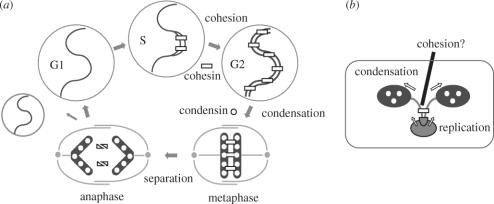Figure 1.
Chromosome segregation in eukaryotes and bacteria. (a) In eukaryotic cells, the linkage between duplicated DNA molecules (cohesion) is established during S phase and maintained throughout G2 phase. The cohesin complex (indicated by rectangles) plays a central role in this process. At the onset of mitosis, most cohesin dissociates from chromosomes and is replaced with the condensin complex (indicated by circles), leading to the formation of metaphase chromosomes (condensation). A small amount of cohesin left on the chromosome is sufficient to hold the sister chromatids together. Proteolytic cleavage of cohesin subunits promotes final separation of sister chromatids at anaphase, allowing them to be pulled apart to opposite poles of the cell. (b) In bacterial cells, duplication and segregation of chromosomes occur simultaneously. The SMC protein may promote segregation by pulling and condensing duplicated chromosomes at opposite poles of the cell. It remains controversial whether there may be a process corresponding to cohesion in the bacterial chromosome cycle.

